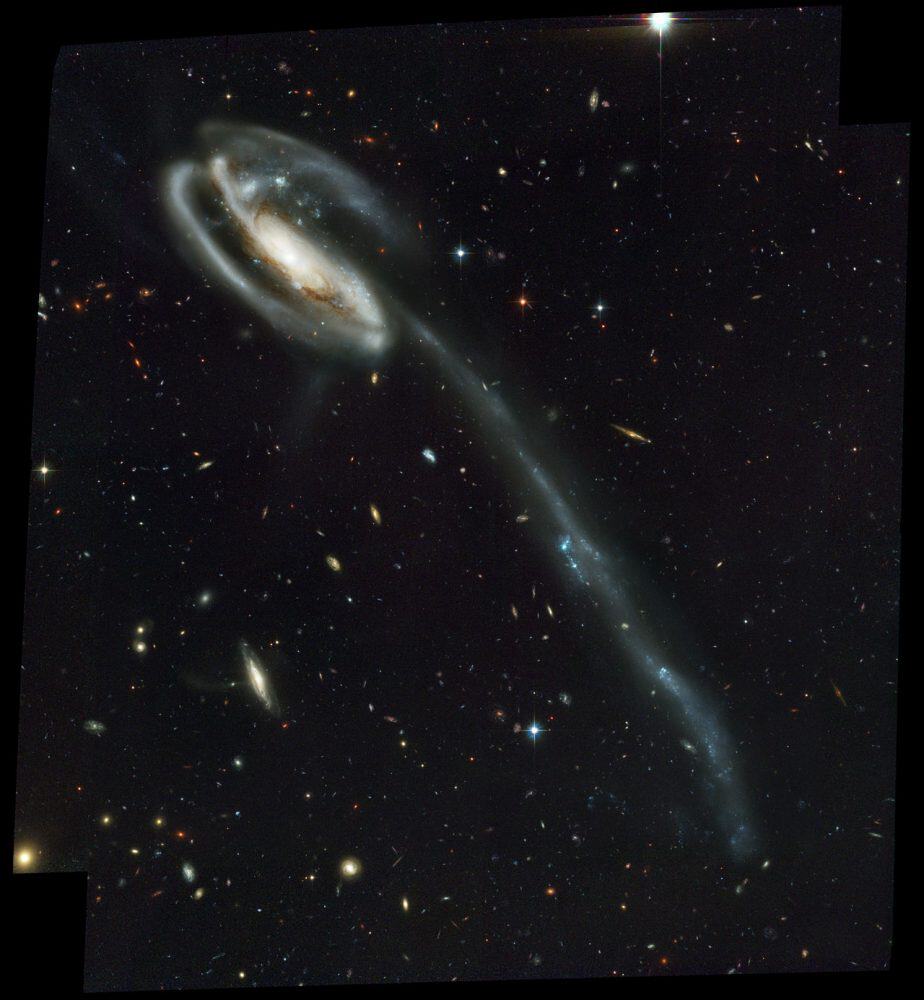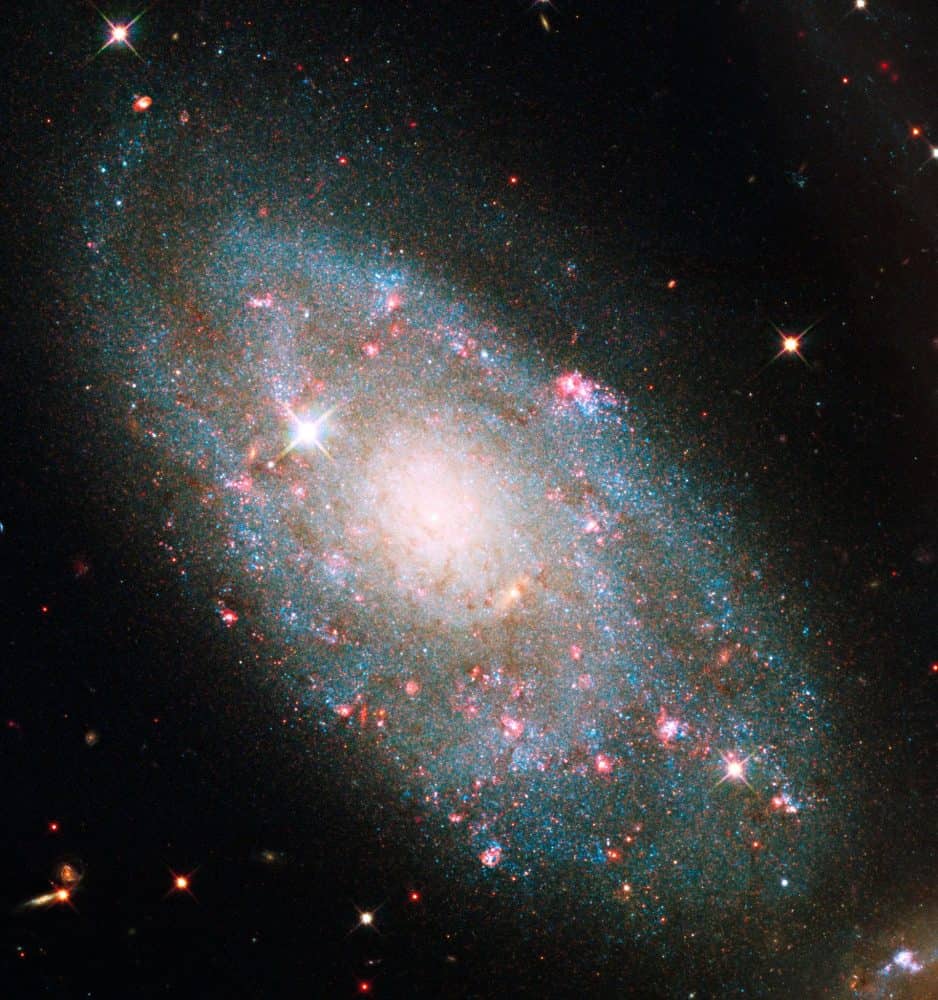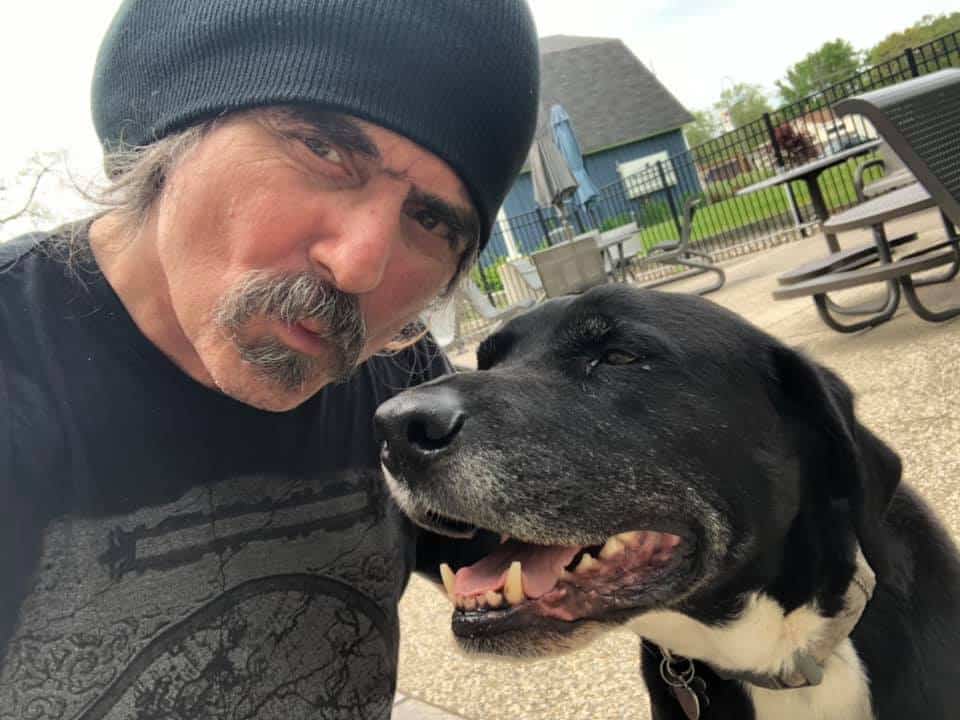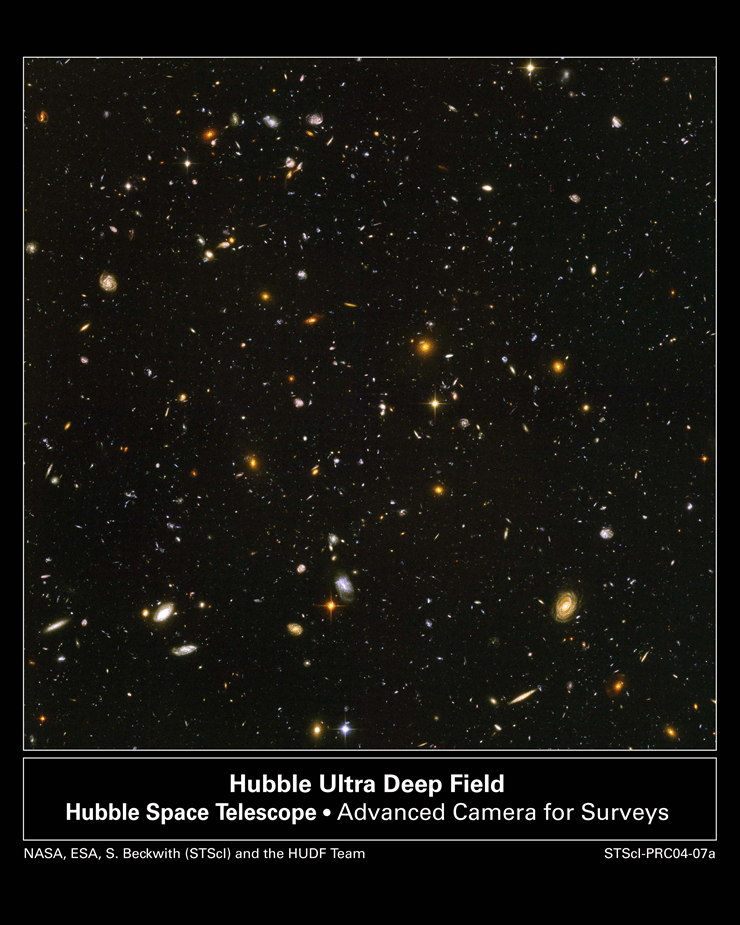Blog
A colliding galaxy dubbed the “Tadpole” (catalog name UGC10214) is set against a rich tapestry of 6,000 galaxies. The Tadpole, with its long tail of stars, looks like a runaway pinwheel firework, unlike the textbook images of stately spiral galaxies. Its distorted shape was caused by a small interloper, a very blue, compact galaxy visible near the more massive Tadpole. The Tadpole resides about 420 million light-years away in the constellation Draco. Seen shining through the Tadpole’s disk, the tiny intruder is likely a hit-and-run galaxy that is now leaving the scene of the accident. Strong gravitational forces from the interaction created the long tail of debris, consisting of stars and gas that stretch out more than 280,000 light-years.
more...Stephanie Lynn “Stevie” Nicks (born May 26, 1948 Phoenix, AZ) is an American singer and songwriter. Nicks is best known for her work as a songwriter and vocalist with Fleetwood Mac, and also for her chart-topping solo career. She is known for her distinctive voice, mystical stage persona and poetic, symbolic lyrics. Collectively, her work both as a member of Fleetwood Mac and as a solo artist has produced over forty top 50 hits and sold over 140 million records, making her one of the best-selling music acts of all time with Fleetwood Mac.
Nicks joined Fleetwood Mac in 1975 along with her then boyfriend, Lindsey Buckingham. Rumours, Fleetwood Mac’s second album after the incorporation of Nicks and Buckingham, was the best-selling album of the year of its release and to date has sold over 40 million copies worldwide, making it the fifth biggest-selling studio album of all time. The album remained at number one on the American albums chart for 31 weeks and reached number one in various countries worldwide. The album won the Grammy Award for Album of the Year in 1978. It produced four US Billboard Hot 100top-ten singles, with Nicks’s “Dreams” being the band’s first and only Billboard Hot 100 number-one hit.
In 1981, while remaining a member of Fleetwood Mac, Nicks began her solo career, releasing the studio album Bella Donna, which topped the Billboard 200 and has reached multiplatinum status.[3] She has released a total of eight solo studio albums to date, with her most recent, titled 24 Karat Gold: Songs from the Vault, released in October 2014.
more...Mark Lavon “Levon” Helm (May 26, 1940 – April 19, 2012) was an American musician and actor who achieved fame as the drummer and one of the vocalists for the Band. Helm was known for his deeply soulful, country-accented voice, multi-instrumental ability, and creative drumming style, highlighted on many of the Band’s recordings, such as “The Weight“, “Up on Cripple Creek“, and “The Night They Drove Old Dixie Down“.
Helm also had a successful career as a film actor, appearing as Loretta Lynn‘s father in Coal Miner’s Daughter, as Chuck Yeager‘s friend and colleague Captain Jack Ridley in The Right Stuff, and as a Tennessee firearms expert in Shooter.
In 1998, Helm was diagnosed with throat cancer, which caused him to lose his singing voice. After treatment, his cancer eventually went into remission, and he gradually regained the use of his voice. His 2007 comeback album Dirt Farmer earned the Grammy Award for Best Traditional Folk Album in February 2008, and in November of that year, Rolling Stone magazine ranked him No. 91 in its list of 100 Greatest Singers of All Time. In 2010, Electric Dirt, his 2009 follow-up to Dirt Farmer, won the first Grammy Award for Best Americana Album, a category inaugurated in 2010. In 2011, his live album Ramble at the Ryman won the Grammy in the same category. On April 17, 2012, his wife and daughter announced on Helm’s website that he was “in the final stages of his battle with cancer” and thanked fans while requesting prayers. Two days later, Helm died at Memorial Sloan-Kettering Cancer Center in New York City.
more...Miles Dewey Davis III (May 26, 1926 – September 28, 1991) was an American jazz trumpeter, bandleader, and composer. He is among the most influential and acclaimed figures in the history of jazz and 20th century music. Davis adopted a variety of musical directions in a five-decade career that kept him at the forefront of many major stylistic developments in jazz.
Born and raised in Alton, Illinois, Davis left to study at the Juilliard School in New York City, before dropping out and making his professional debut as a member of saxophonist Charlie Parker‘s bebop quintet from 1944 to 1948. Shortly after, he recorded the Birth of the Cool sessions for Capitol Records, which were instrumental to the development of cool jazz. In the early 1950s, Miles Davis recorded some of the earliest hard bop music while on Prestige Records but did so haphazardly due to a heroin addiction. After a widely acclaimed comeback performance at the Newport Jazz Festivalin 1955, he signed a long-term contract with Columbia Records and recorded the 1957 album ‘Round About Midnight. It was his first work with saxophonist John Coltrane and bassist Paul Chambers, key members of the sextet he led into the early 1960s. During this period, he alternated between orchestral jazz collaborations with arranger Gil Evans, such as the Spanish-influenced Sketches of Spain (1960), and band recordings, such as Milestones (1958) and Kind of Blue (1959). The latter recording remains one of the most popular jazz albums of all time, having sold over four million copies in the U.S.
Davis made several line-up changes while recording Someday My Prince Will Come (1961), his 1961 Blackhawk concerts, and Seven Steps to Heaven (1963), another mainstream success that introduced bassist Ron Carter, pianist Herbie Hancock, and drummer Tony Williams. After adding saxophonist Wayne Shorter to his new quintet in 1964, Davis led them on a series of more abstract recordings often composed by the band members, helping pioneer the post-bop genre with albums such as E.S.P (1965) and Miles Smiles (1967), before transitioning into his electric period. During the 1970s, he experimented with rock, funk, African rhythms, emerging electronic music technology, and an ever-changing line-up of musicians, including keyboardist Joe Zawinul, drummer Al Foster, and guitarist John McLaughlin. This period, beginning with Davis’ 1969 studio album In a Silent Way and concluding with the 1975 concert recording Agharta, was the most controversial in his career, alienating and challenging many in jazz. His million-selling 1970 record Bitches Brew helped spark a resurgence in the genre’s commercial popularity with jazz fusion as the decade progressed.
https://www.youtube.com/watch?v=qiL0jDqjlcA
more...Rubén González Fontanills (May 26, 1919 – December 8, 2003) was a Cuban pianist. Together with Lilí Martínez and Peruchín he is said to have “forged the style of modern Cuban piano playing in the 1940s”.
Between the 1940s and his retirement in the 1980s, he played with Cuba’s most successful acts, including Paulina Álvarez, Arsenio Rodríguez, Orquesta América del 55, Orquesta Riverside and Enrique Jorrín. In the 1990s, he came out of retirement to play in the revival ensembles Afro-Cuban All Stars and Buena Vista Social Club, also recording solo material and performing live until 2002.
more...https://www.youtube.com/watch?v=i2eenLfCw-c
more...NGC 7320 is a spiral galaxy in the Stephan’s Quintet. However, it is not an actual member of the galaxy group, but a much closer line-of-sight galaxy at a distance of about 40 million light years. Other galaxies of Stephan’s Quintet are some 300 million light-year distant.
more...Wallace Roney (born May 25, 1960, Philadelphia) is an American jazz (hard bop and post-bop) trumpeter.[1]
Roney took lessons from Clark Terry and Dizzy Gillespie and studied with Miles Davis from 1985 until the latter’s death in 1991. Wallace credits Davis as having helped to challenge and shape his creative approach to life as well as being his music instructor, mentor, and friend; he was the only trumpet player Davis personally mentored.
Roney was born in Philadelphia and attended Howard University and Berklee College of Music in Boston, Massachusetts, after graduating from the Duke Ellington School of the Arts of the D. C. Public Schools, where he studied trumpet with Langston Fitzgerald of the Baltimore Symphony Orchestra. Found to have perfect pitch at the age of four, Wallace began his musical and trumpet studies at Philadelphia’s Settlement School of Music.
He studied with trumpeter Sigmund Hering of the Philadelphia Orchestra for three years. Hering regularly presented Wallace at recitals at the Settlement School, and with the Philadelphia Brass Ensemble, during his studies in Philadelphia.
more...Jimmy Hamilton (May 25, 1917 – September 20, 1994) was an American jazz clarinetist, tenor saxophonist, arranger, composer, and music educator, best known for his twenty-five years with Duke Ellington.
Hamilton was born in Dillon, South Carolina, and grew up in Philadelphia. Having originally learned to play piano and brass instruments, in the 1930s he started playing the latter in local bands, before switching to clarinet and saxophone. In 1939 he played with Lucky Millinder, Jimmy Mundy, and Bill Doggett, going on to join the Teddy Wilson sextet in 1940. After two years with Wilson, he played with Eddie Heywood and Yank Porter.
In 1943, he replaced Barney Bigard in the Duke Ellington orchestra, and stayed with Ellington until 1968. His style was very different on his two instruments: on tenor saxophone he had an R&B sound, while on clarinet he was much more precise and technical. He wrote some of his own material in his time with Ellington.
After he left the Ellington orchestra, Hamilton played and arranged on a freelance basis, before spending the 1970s and 1980s in the Virgin Islandsteaching music. On his retirement from teaching he continued to perform with his own groups in 1989 and 1990. Hamilton died September 20, 1994 in St. Croix, Virgin Islands, at the age of 77.
more...Bill “Bojangles” Robinson (May 25, 1877 – November 25, 1949 Richmond, VA) was an American tap dancer and actor, the best known and most highly paid African-American entertainer in the first half of the twentieth century. His long career mirrored changes in American entertainment tastes and technology. He started in the age of minstrel shows and moved to vaudeville, Broadway, the recording industry, Hollywood, radio, and television. According to dance critic Marshall Stearns, “Robinson’s contribution to tap dance is exact and specific. He brought it up on its toes, dancing upright and swinging”, giving tap a “…hitherto-unknown lightness and presence.”:pp. 186–187 His signature routine was the Stair Dance, in which Robinson would tap up and down a set of stairs in a rhythmically complex sequence of steps, a routine that he unsuccessfully attempted to patent. Robinson is also credited with having introduced a new word, copasetic, into popular culture, via his repeated use of it in vaudeville and radio appearances.
A popular figure in both the black and white entertainment worlds of his era, he is best known today for his dancing with Shirley Temple in a series of films during the 1930s, and for starring in the musical Stormy Weather (1943), loosely based on Robinson’s own life, and selected for preservation in the National Film Registry. Robinson used his popularity to challenge and overcome numerous racial barriers, including becoming the following:
- one of the first minstrel and vaudeville performers to appear without the use of blackface makeup
- one of the earliest African-American performers to go solo, overcoming vaudeville’s two-colored rule
- a headliner in Broadway shows
- the first African American to appear in a Hollywood film in an interracial dance team (with Temple in The Little Colonel, 1935)
- the first African American to headline a mixed-race Broadway production
During his lifetime and afterwards, Robinson also came under heavy criticism for his participation in and tacit acceptance of racial stereotypes of the era, with critics calling him an Uncle Tom figure. Robinson resented such criticism, and his biographers suggested that critics were at best incomplete in making such a characterization, especially given his efforts to overcome the racial prejudice of his era. In his public life Robinson led efforts to:
- persuade the Dallas police department to hire its first African-American policemen
- lobby President Franklin Delano Roosevelt during World War II for more equitable treatment of African-American soldiers
- stage the first integrated public event in Miami, a fundraiser which, with the permission of the mayor, was attended by both black and white city residents
Despite being the highest-paid black performer of the era, Robinson died penniless in 1949, and his funeral was paid for by longtime friend Ed Sullivan. Robinson is remembered for the support he gave to fellow performers, including Fred Astaire, Lena Horne, Jesse Owens, and the Nicholas brothers.
more...Malaysian ensemble
more...3,000 galaxies, large and small, shapely and amorphous, burning in the depths of space. The stunning image was called the Hubble Deep Field.
In subsequent years, Hubble teamed with other observatories to examine small patches of the sky in high resolution, long exposures, and multiple wavelengths. The deeper Hubble sees into space, the farther it gazes back in time. This chart illustrates the regions that have fallen under Hubble’s eye.
Surveys like the Hubble Ultra Deep Field (HUDF) and the Great Observatories Origins Deep Survey (GOODS) have provided pictures of vast, deep collections of galaxies – including some that existed when the universe was less than a billion years old.
The images allow us to follow the development of the universe. Tiny red dots — early, shapeless galaxy building blocks whose light has been stretched by the expanding universe into an infrared glow – litter the most distant parts of the visible universe. Closer in, we see numerous galaxy interactions and collisions as galaxies come together and merge, growing in the process. And nearer still, we see versions of the large, stately galaxies we know today.
more...Bob Dylan (born Robert Allen Zimmerman on May 24, 1941 Duluth, MN) is an American singer-songwriter, author, and visual artist who has been a major figure in popular culture for six decades. Much of his most celebrated work dates from the 1960s, when songs such as “Blowin’ in the Wind” (1963) and “The Times They Are a-Changin’” (1964) became anthems for the Civil Rights Movement and anti-war movement. His lyrics during this period incorporated a wide range of political, social, philosophical, and literary influences, defied pop-music conventions and appealed to the burgeoning counterculture.
Following his self-titled debut album in 1962, which mainly comprised traditional folk songs, Dylan made his breakthrough as a songwriter with the release of The Freewheelin’ Bob Dylan the following year. The album featured “Blowin’ in the Wind” and the thematically complex “A Hard Rain’s a-Gonna Fall“. For many of these songs he adapted the tunes and sometimes phraseology of older folk songs. He went on to release the politically charged The Times They Are a-Changin’ and the more lyrically abstract and introspective Another Side of Bob Dylan in 1964. In 1965 and 1966, Dylan encountered controversy when he adopted electrically amplified rock instrumentation, and in the space of 15 months recorded three of the most important and influential rock albums of the 1960s: Bringing It All Back Home (1965), Highway 61 Revisited (1965) and Blonde on Blonde (1966). The six-minute single “Like a Rolling Stone” (1965) radically expanded what a pop song could convey.
In July 1966, Dylan withdrew from touring after being injured in a motorcycle accident. During this period he recorded a large body of songs with members of the Band, who had previously backed him on tour. These recordings were released as the collaborative album The Basement Tapes, in 1975. In the late 1960s and early 1970s, Dylan explored country music and rural themes in John Wesley Harding (1967), Nashville Skyline (1969), and New Morning (1970). In 1975, he released Blood on the Tracks, which many saw as a return to form. In the late 1970s, he became a born-again Christian and released a series of albums of contemporary gospel music before returning to his more familiar rock-based idiom in the early 1980s. The major works of his later career include Time Out of Mind (1997), “Love and Theft” (2001), Modern Times (2006) and Tempest (2012). His most recent recordings have comprised versions of traditional American standards, especially songs recorded by Frank Sinatra. Backed by a changing lineup of musicians, he has toured steadily since the late 1980s on what has been dubbed the Never Ending Tour.
Since 1994, Dylan has published eight books of drawings and paintings, and his work has been exhibited in major art galleries. He has sold more than 100 million records, making him one of the best-selling music artists of all time. He has also received numerous awards including ten Grammy Awards, a Golden Globe Award, and an Academy Award. Dylan has been inducted into the Rock and Roll Hall of Fame, Minnesota Music Hall of Fame, Nashville Songwriters Hall of Fame, and the Songwriters Hall of Fame. The Pulitzer Prize jury in 2008 awarded him a special citation for “his profound impact on popular music and American culture, marked by lyrical compositions of extraordinary poetic power”. In 2012, Dylan received the Presidential Medal of Freedom, and in 2016, he was awarded the Nobel Prize in Literature “for having created new poetic expressions within the great American song tradition”.
more...Archie Shepp (born May 24, 1937) is an American jazz saxophonist.
Shepp was born in Fort Lauderdale, Florida, but raised in Philadelphia, Pennsylvania. He studied piano, clarinet, and alto saxophone before focusing on tenor saxophone. He occasionally plays soprano saxophone and piano. He studied drama at Goddard College from 1955 to 1959.
He played in a Latin jazz band for a short time before joining the band of avant-garde pianist Cecil Taylor. Shepp’s first recording under his own name, Archie Shepp – Bill Dixon Quartet, was released on Savoy Records in 1962 and featured a composition by Ornette Coleman. Along with John Tchicaiand Don Cherry, he was a member of the New York Contemporary Five. John Coltrane‘s admiration led to recordings for Impulse! Records, the first of which was Four for Trane in 1964, an album of mainly Coltrane compositions on which he was joined by trombonist Roswell Rudd, bassist Reggie Workman and alto player John Tchicai.
more...https://www.youtube.com/watch?v=0XHJvRr7TR4&list=PLF183036912DCA301&index=2&t=0s
more...More Posts
- Gary Burton
- Curtis Counce
- Django Reinhardt
- World Music Rémi Geffroy
- Daily Roots Tommy McCook
- Garth Hudson Memorial
- Mardi Gras Day 2025
- Zimbabwean Proverb
- Cosmo NGC 7000
- Hammie Nixon
- Blind Willie Johnson
- Eberhard Weber
- Sam Cooke
- J.J. Johnson
- World Music La Pambelé
- Daily Roots The Aggrovators
- Echos of Freedom by Dr Martin Luther King Jr
- Cosmo NGC 2244
- Richie Havens
- Snooks Eaglin



